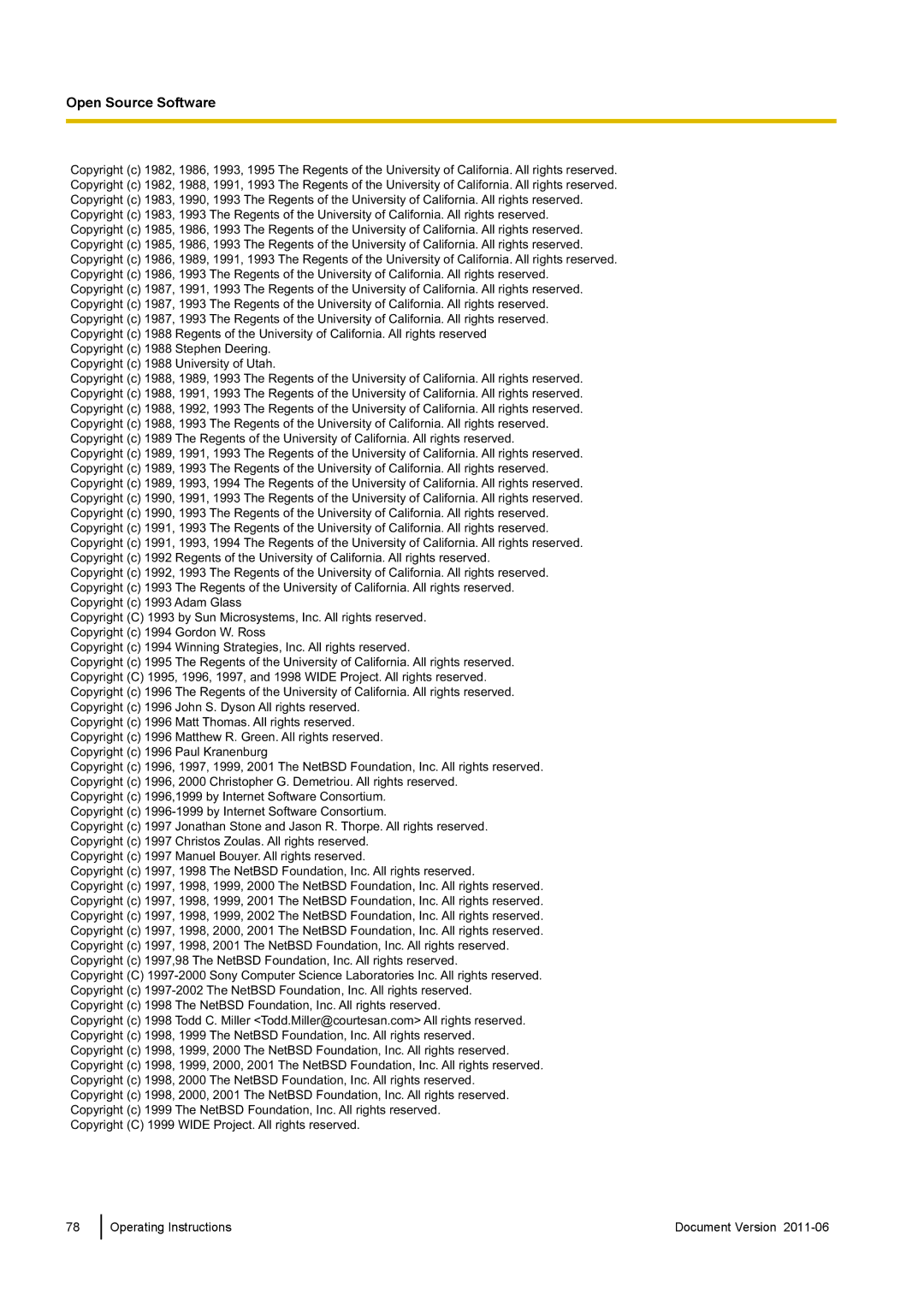Copyright (c) 1982, 1986, 1993, 1995 The Regents of the University of California. All rights reserved. Copyright (c) 1982, 1988, 1991, 1993 The Regents of the University of California. All rights reserved. Copyright (c) 1983, 1990, 1993 The Regents of the University of California. All rights reserved.
Copyright (c) 1983, 1993 The Regents of the University of California. All rights reserved. Copyright (c) 1985, 1986, 1993 The Regents of the University of California. All rights reserved. Copyright (c) 1985, 1986, 1993 The Regents of the University of California. All rights reserved. Copyright (c) 1986, 1989, 1991, 1993 The Regents of the University of California. All rights reserved. Copyright (c) 1986, 1993 The Regents of the University of California. All rights reserved.
Copyright (c) 1987, 1991, 1993 The Regents of the University of California. All rights reserved. Copyright (c) 1987, 1993 The Regents of the University of California. All rights reserved. Copyright (c) 1987, 1993 The Regents of the University of California. All rights reserved. Copyright (c) 1988 Regents of the University of California. All rights reserved
Copyright (c) 1988 Stephen Deering.
Copyright (c) 1988 University of Utah.
Copyright (c) 1988, 1989, 1993 The Regents of the University of California. All rights reserved. Copyright (c) 1988, 1991, 1993 The Regents of the University of California. All rights reserved. Copyright (c) 1988, 1992, 1993 The Regents of the University of California. All rights reserved. Copyright (c) 1988, 1993 The Regents of the University of California. All rights reserved.
Copyright (c) 1989 The Regents of the University of California. All rights reserved.
Copyright (c) 1989, 1991, 1993 The Regents of the University of California. All rights reserved. Copyright (c) 1989, 1993 The Regents of the University of California. All rights reserved. Copyright (c) 1989, 1993, 1994 The Regents of the University of California. All rights reserved. Copyright (c) 1990, 1991, 1993 The Regents of the University of California. All rights reserved. Copyright (c) 1990, 1993 The Regents of the University of California. All rights reserved. Copyright (c) 1991, 1993 The Regents of the University of California. All rights reserved. Copyright (c) 1991, 1993, 1994 The Regents of the University of California. All rights reserved. Copyright (c) 1992 Regents of the University of California. All rights reserved.
Copyright (c) 1992, 1993 The Regents of the University of California. All rights reserved. Copyright (c) 1993 The Regents of the University of California. All rights reserved. Copyright (c) 1993 Adam Glass
Copyright (C) 1993 by Sun Microsystems, Inc. All rights reserved. Copyright (c) 1994 Gordon W. Ross
Copyright (c) 1994 Winning Strategies, Inc. All rights reserved.
Copyright (c) 1995 The Regents of the University of California. All rights reserved. Copyright (C) 1995, 1996, 1997, and 1998 WIDE Project. All rights reserved. Copyright (c) 1996 The Regents of the University of California. All rights reserved. Copyright (c) 1996 John S. Dyson All rights reserved.
Copyright (c) 1996 Matt Thomas. All rights reserved. Copyright (c) 1996 Matthew R. Green. All rights reserved. Copyright (c) 1996 Paul Kranenburg
Copyright (c) 1996, 1997, 1999, 2001 The NetBSD Foundation, Inc. All rights reserved. Copyright (c) 1996, 2000 Christopher G. Demetriou. All rights reserved.
Copyright (c) 1996,1999 by Internet Software Consortium. Copyright (c) 1996-1999 by Internet Software Consortium.
Copyright (c) 1997 Jonathan Stone and Jason R. Thorpe. All rights reserved. Copyright (c) 1997 Christos Zoulas. All rights reserved.
Copyright (c) 1997 Manuel Bouyer. All rights reserved.
Copyright (c) 1997, 1998 The NetBSD Foundation, Inc. All rights reserved.
Copyright (c) 1997, 1998, 1999, 2000 The NetBSD Foundation, Inc. All rights reserved. Copyright (c) 1997, 1998, 1999, 2001 The NetBSD Foundation, Inc. All rights reserved. Copyright (c) 1997, 1998, 1999, 2002 The NetBSD Foundation, Inc. All rights reserved. Copyright (c) 1997, 1998, 2000, 2001 The NetBSD Foundation, Inc. All rights reserved. Copyright (c) 1997, 1998, 2001 The NetBSD Foundation, Inc. All rights reserved.
Copyright (c) 1997,98 The NetBSD Foundation, Inc. All rights reserved.
Copyright (C) 1997-2000 Sony Computer Science Laboratories Inc. All rights reserved. Copyright (c) 1997-2002 The NetBSD Foundation, Inc. All rights reserved.
Copyright (c) 1998 The NetBSD Foundation, Inc. All rights reserved.
Copyright (c) 1998 Todd C. Miller <Todd.Miller@courtesan.com> All rights reserved. Copyright (c) 1998, 1999 The NetBSD Foundation, Inc. All rights reserved. Copyright (c) 1998, 1999, 2000 The NetBSD Foundation, Inc. All rights reserved. Copyright (c) 1998, 1999, 2000, 2001 The NetBSD Foundation, Inc. All rights reserved. Copyright (c) 1998, 2000 The NetBSD Foundation, Inc. All rights reserved.
Copyright (c) 1998, 2000, 2001 The NetBSD Foundation, Inc. All rights reserved. Copyright (c) 1999 The NetBSD Foundation, Inc. All rights reserved.
Copyright (C) 1999 WIDE Project. All rights reserved.

